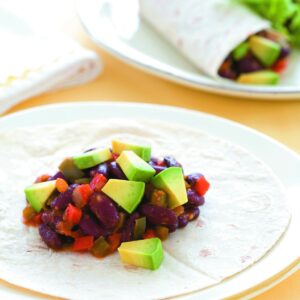
Test your food knowledge with our quick and fun quiz!
Q: True or false? A large boiled egg has more protein than a small can of tuna.
Answer: False. A small 95g can of tuna has around 16g of protein, while the humble boiled egg contains around 5.5g. Both are terrific snacks that boost protein intake and are good for adding to recipes. Tuna canned in brine is high in salt so a better choice is tuna canned in springwater.
Q: Which nutrient is the most filling?
- Fat
- Carbohydrate
- Protein
Answer: Protein. People with higher-protein diets experience less hunger and are better able to maintain a healthy body weight. Fibre-filled, low-GI carbohydrates also keep you feeling full for longer. For a healthy, satisfying brekkie, have a protein-rich fruit smoothie made with reduced-fat milk, and a slice of grainy toast with peanut butter.
Q: Which type of sugar has the most kilojoules per teaspoon?
- Raw sugar
- White sugar
- Honey
Answer: Honey. A teaspoon of honey has 94 kilojoules (22cal) compared to a teaspoon of white or raw sugar, which both contain 67 kilojoules (16cal). The difference is minuscule, but what’s important to note is that sugar is sugar, and should be consumed sparingly in any form.
Q: Which is a cruciferous vegetable?
- Broccoli
- Corn
- Potato
- Carrot
Answer: Broccoli. The cruciferous family also includes cauliflower, cabbage, kale, bok choy, rocket, Brussels sprouts, watercress and radish. While most cruciferous vegetables are rich in vitamins and minerals, such as folate and vitamins K and A, broccoli really packs a nutritional punch. Just one cup of broccoli contains 90 per cent of your daily vitamin C needs and 77 per cent of your daily vitamin K requirements.
Q: What is a healthy portion of nuts?
- 10g
- 30g
- 100g
Answer: 30g, which is about a handful of mixed nuts or, more specifically, 20 almonds, 15 cashews, 30 pistachios, 10 Brazil nuts or two tablespoons of pine nuts. Eating a healthy portion of nuts every day has been linked to a reduced risk of developing heart disease. To manage portions, divide a large packet of nuts into 30g servings and store in smaller containers or zip-lock bags.
Q: Which bread has a lower glycaemic index (GI)?
- Sourdough
- Wholemeal
Answer: Sourdough. Both are more filling than white bread, but authentic sourdough made with lactobacillus culture has a GI of around 54, while wholemeal bread has around 74. Many supermarket sourdoughs are not made with lactobacillus, so have a similar GI to white bread, which can be as high as 90 (glucose is 100).
Q: True or false? Coconut oil is better for you than olive oil.
Answer: False. Gram for gram, coconut oil and olive oil contain the same number of kilojoules, but olive oil has just 16 per cent saturated fat, compared to the 92 per cent found in coconut
oil. The science supporting the health benefits of coconut oil is limited, whereas strong evidence exists for olive oil, linking its consumption to a reduced risk of heart disease and some cancers.
Q: Which milk has the most protein per 250ml glass?
- Almond milk
- Skim milk
- Soy milk
- Full-fat milk
Answer: Skim milk. When fat is removed from milk, additional skim milk powder, which is loaded with protein and calcium, is often added. This gives skim milk 9.25g of protein per 250ml glass, whereas full-fat milk has 8.75g per glass. Soy milk has around 7.5g, thanks to protein-rich soy beans.
In contrast, almond milk has a mere 1g of protein.
Q: Which of the following foods are gluten free?
- Brown rice
- Plain corn chips
- Milk chocolate
- Popcorn
Answer: They all are! As you can see, being gluten free doesn’t guarantee a food is healthy. So always look beyond the front-of-pack marketing claims and find out what else a food contains. Take extra care when choosing packaged gluten-free foods, such as biscuits, muffins and cake mixes, as these can be high in kilojoules.
Q:Which foods contain the energy-boosting mineral iron?
- Spinach
- Steak
- Wholegrain bread
- Kidney beans
Answer: All of them! Iron is found in both animal and plant sources, but the human body is better able to absorb the iron in red meat. You can increase your iron absorption from plants by pairing them with foods rich in vitamin C. For example, include red capsicum strips in your next broccoli stir-fry or toss orange segments into a spinach salad.
Q: Which has more saturated fat?
- 30g banana chips
- Small McDonald’s fries
Answer: Banana chips. A handful of dried banana chips has around 8.2g of saturated fat, which is 7g more than fried chips (1.2g sat fat). Why? Most banana chips are deep fried in coconut oil. (So the sweetness is also due to added sugar!)
Q: Which antioxidant is found in purple fruits and vegetables?
- Anthocyanin
- Vitamin A
- Beta-carotene
Answer: Anthocyanin. This antioxidant has been linked to improved vision, as well as a reduced risk of cancer, cardiovascular disease and cognitive decline. You’ll find anthocyanin in foods such as red cabbage, blackberries, blueberries, eggplant and purple sweet potatoes.
Q: Rank these foods from lowest to highest in kilojoules/calories.
- One medium-sized banana
- 2 slices (40g) full-fat tasty cheese
- 5 dried apricot halves
- 10 macadamias
Answer:
- Dried apricots (264kJ/63cal)
- Banana (414kJ/99cal)
- Cheese (585kJ/140cal)
- Macadamias (1040kJ/249cal)
When considering kilojoules/calories, it’s important to consider a food’s overall nutritional value, too. For example, while macadamia nuts are densely packed with good fats, making them the highest in kilojoules, these fats help to lower your total and LDL (bad) cholesterol levels. Macadamias are also packed with antioxidants, which can help reduce your risk of developing various diseases.
Q: What is the recommended daily intake of fibre for an adult per day?
- 5–10g
- 10–20g
- 25–30g
Answer: For optimal health, dietary guidelines recommend adults consume between 25–30 grams of fibre a day. Fibre-filled foods include fresh fruit and vegetables, whole grains, legumes, nuts and seeds. Enjoying a high-fibre diet is linked to a reduced risk of heart disease, stroke, type 2 diabetes, bowel cancer and more.
Q. Which food contains the highest amount of potassium?
- One large white potato (boiled)
- 85g of beetroot (peeled and boiled)
- One cup of yoghurt
Answer: One white potato packs a whopping 1100mg of potassium, and a 300g serve has almost a quarter of the recommended daily intake (4700mg). Yoghurt is next with 380mg potassium. Bringing up the rear is beetroot, which still contains an admirable 259mg per 85g serve. The body doesn’t make potassium, so we need to get enough of it through diet to support bone and heart health. Potassium is also associated with reducing the risk of stroke and heart disease pressure.
www.healthyfood.com










